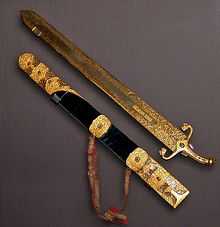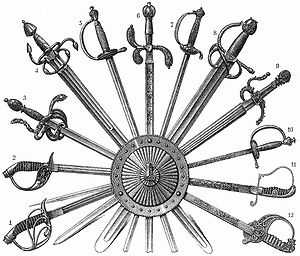Sword of Osman

Osman's sword on display
The Sword of Osman (Ottoman Turkish: Taklid-i Seyf; Turkish: Osman Kılıcı)[1] was an important sword of state used during the coronation ceremony (Turkish: 'Kılıç alayı') of the sultans of the Ottoman Empire.[2] The sword was named after Osman I, founder of the Ottoman Dynasty. The practice started when Osman I was girt with the sword of Islam by his mentor and father-in-law Sheikh Edebali.[3] The girding of the sword of Osman was a vital ceremony which took place within two weeks of a sultan's accession to the throne. It was held at the tomb complex at Eyüp, on the Golden Horn waterway in the capital Constantinople. Even though the journey from Topkapı Palace (where the sultan resided) to the Golden Horn was short, the sultan would board a boat amid much pomp to go there. The Eyüp tomb complex was built by Mehmed II in honour of Abu Ayyub al-Ansari, a companion of Muhammad who had died during the first Muslim siege of Constantinople in the 7th century. The sword girding thus occurred on what was regarded as sacred grounds, and linked the newly enthroned sultan both to his 13th-century ancestors and to Muhammad himself.[4]
The fact that the emblem by which a sultan was enthroned consisted of a sword was highly symbolic: it showed that the office with which he was invested was first and foremost that of a warrior. The Sword of Osman was girded on to the new sultan by the Sharif of Konya, a Mevlevi dervish, who was summoned to Constantinople for that purpose. Such a privilege was reserved to the men of this Sufi order from the time Osman I had established his residence in Konya in 1299, before the capital was moved to Bursa and later to Constantinople.[5]
Until the late 19th century, non-Muslims were banned from entering the Eyüp Mosque and witnessing the girding ceremony. The first to depart from this tradition was Mehmed V, whose girding ceremony was open to people of different faiths. Held on 10 May 1909, it was attended by representatives of all the religious communities present in the empire, notably the Sheikh ul-Islam, Greek Patriarch, the chief rabbi and a representative of the Armenian Church. The fact that non-Muslims were allowed to see the ceremony enabled The New York Times to write an extremely detailed account of it.[6] Mehmed V's brother and successor, Mehmed VI, went even further by allowing his girding ceremony to be filmed. Since he was the last reigning Ottoman sultan, this is the only such ceremony that was ever put on film.[7]
References
- ↑ M'Gregor, J. (July 1854). "The Race, Religions, and Government of the Ottoman Empire". The Eclectic Magazine of Foreign Literature, Science, and Art (New York: Leavitt, Trow, & Co.) 32: 376. OCLC 6298914. Retrieved 2009-04-25.
- ↑ Hasluck 2007, pp. 604–622
- ↑ Bagley 1969, p. 2
- ↑ Quataert 2005, p. 93
- ↑ "Girding on the Sword of Osman" (PDF). The New York Times: 2. 1876-09-18. ISSN 0362-4331. Retrieved 2009-04-19.
- ↑ "New Sultan Breaks Moslem Traditions" (PDF). The New York Times: 4. 1909-05-11. ISSN 0362-4331. Retrieved 2009-04-19.
- ↑ Abdullah Kirbaçoglu (cinematographer) (1918-07-04). Crowning of Mehmed VI as last Sultan of the Ottoman Empire in 1918 (Documentary). Amsterdam: MokumTV. Retrieved 2009-04-19.
Bibliography


